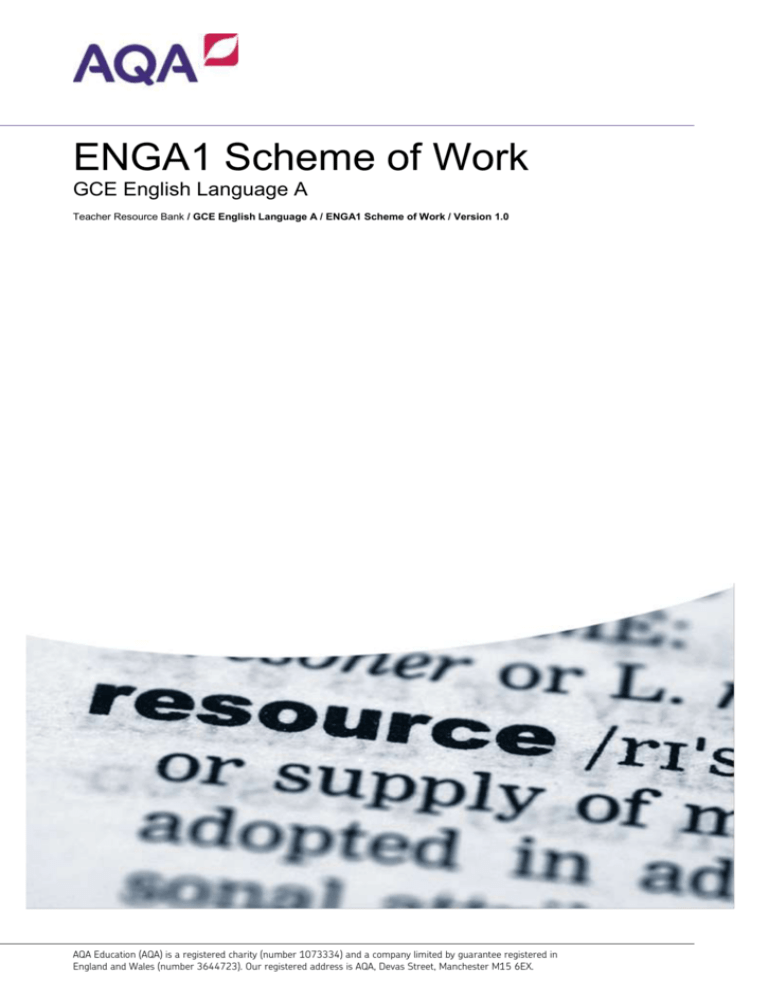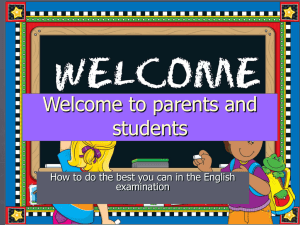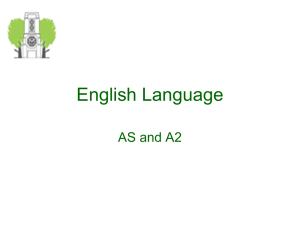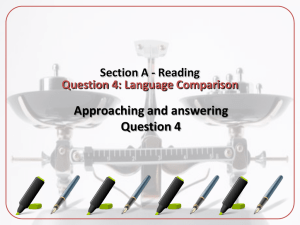ENGA1 Scheme of Work
advertisement

ENGA1 Scheme of Work GCE English Language A Teacher Resource Bank / GCE English Language A / ENGA1 Scheme of Work / Version 1.0 AQA Education (AQA) is a registered charity (number 1073334) and a company limited by guarantee registered in England and Wales (number 3644723). Our registered address is AQA, Devas Street, Manchester M15 6EX. ENGA1 SCHEME OF WORK: SEEING THROUGH LANGUAGE This Scheme of Work is offered as an example to provide guidance. It is not intended to be prescriptive and is meant to outline one of many pathways by which the Unit could be taught. All items are, therefore, suggestions and there is no requirement that this example should be followed. Section A – Language and Mode Useful Texts: English Language (Specification A), Nelson Thornes, 2008 R CARTER et al, Working with texts, Routledge, 2001 F PRIDHAM, The Language of Conversation, Routledge (Intertext), 2001 R CARTER and S COMFLEET, The Language of Speech and Writing, Routledge (Intertext), 2001 M BOARDMAN, The Language of Websites, Routledge (Intertext), 2004 1 Spoken texts – Identify a range of spoken genres such as monologues, anecdotes, speeches, interactions, formal (interviews, consultations) and informal (social chat with friends/family). Past papers from the present specification are of use here (ENA3 and ENA1 – pre 2005). Introduce mode characteristics – general (spoken, planned/unplanned, formal/ informal, standard/non-standard, transactional/interactional, fluent/non-fluent, permanent/ephemeral, distant/close, delayed/immediate) and particular (rhetorical devices in political speeches and monologic anecdotes). 2 Contextual factors – examine a variety of spoken texts and discuss contextual factors such as: Participants’ context – age – gender – education – status - identity/role Tenor – relationships between participants – politeness – shared knowledge – levels of formality Purposes – amuse – inform – instruct – discover – console – reveal – disguise – repeat etc Topics – Subject/s of conversation – topic management (function of discourse markers) Structure – adjacency pairs – Initiation/Response/Feedback – cohesion –– anaphors – narrative. 3 Linguistic features – examine a variety of spoken texts and identify: Lexis – words – complexity – levels of formality Semantic – meanings – denotations – connotations – idioms – similes – metaphors – semantic fields – synonymy – antonymy – collocation – pragmatic meanings – context dependence (deixis) Grammar – word classes and types (nouns, verbs, adjectives, adverbs) – pronouns – prepositions – connectives – verb person, number, tense, aspect, voice – modal auxiliaries Syntax – sentence types (minor, simple, compound, complex) – functions – voices – types of clause (main, co-ordinate, sub-ordinate) – ellipsis – compounding – clause linking – hypotaxis – parataxis Discourse – monitoring/feedback – hedges – overlaps – tag questions – non-fluency features – discourse markers – repetition – re-formulation – pseudo-agreements Phonology – Stress, alliteration, assonance, rhyme, rhythm Non-verbal features. AQA Education (AQA) is a registered charity (number 1073334) and a company limited by guarantee registered in England and Wales (number 3644723). Our registered address is AQA, Devas Street, Manchester M15 6EX. 2 of 7 These contextual factors and linguistic features will apply, with minor modifications, to the various sections of the Scheme of Work which follow. 4 Analyse spoken texts. Examine and discuss a variety of spoken texts using the contextual and linguistic frameworks acquired in 1, 2, 3 above. Students could be tasked with obtaining recordings for analysis (off-air, for instance). In their analysis students will examine how language varies according to context and will: identify a text’s distinctive language features describe them using linguistic frameworks explain how they are influenced by the context (eg audience/purpose/topic/mode) interpret how meanings are created and conveyed. In writing their answers, students may find it helpful to use the analytical sentence: linguistic description – illustrative quotation – explanation/interpretation By providing these three elements students will ensure that they are hitting the relevant Assessment Objectives – AO1 and AO3. 5 Analyse spoken texts. Assess progress for this section of the course of study. 6 Written texts – Identify a range of written genres ranging from informal post-it reminders, post cards, letters to formal articles and text books. Past papers from the present specification ENA1 are of use here. Examine general mode characteristics of writing (sometimes collaborative but mainly isolated, planned, standard, distant). Examine the physiology of writing (pen, paper, handwriting, keyboard, printer, private communication, publication, spelling, proof-reading, spell-check). 7 Examine contextual factors (as 2 above with the addition of tenor as relationship between writer and audience enacted by a text with a lack of immediate feedback). Examine linguistic features (as 3 above with the addition of graphology such as design, lay out, font etc). 8 Analyse written texts – examine and discuss mode issues by analysing a variety of written texts using the linguistic and contextual frameworks acquired in 6 and 7 above. Students could be asked to find or provide a variety of examples of writing based on their own interests. 9 Analyse spoken and written texts – pair written and spoken texts and discuss similarities and differences in modes, contexts and linguistic features. Assess progress for this section of the course of study. 10 Electronic texts (written) – Identify a range of electronic writing genres ranging from informal chat facilities and texts to blogs and web pages. Examine some general mode characteristics of electronic writing such as broadband, Wi-Fi, keyboard skills and the function of the send key. Consider features such as the rapid response possible at a distance using the internet. 11 Examine and discuss mode issues by analysing a variety of electronic written texts using the linguistic and contextual frameworks acquired in 7 above. Students could be asked to find or provide a variety of examples of electronic writing. AQA Education (AQA) is a registered charity (number 1073334) and a company limited by guarantee registered in England and Wales (number 3644723). Our registered address is AQA, Devas Street, Manchester M15 6EX. 3 of 7 12 Analyse written and electronic texts. Pair written and electronic texts and discuss similarities and differences in modes, contexts and linguistic features. Assess progress for this section of the course of study. 13 Electronic texts (spoken) – Identify a range of electronic speech genres ranging from land-line and mobile phones, messaging, social chats, business and ‘cold’ calls, radio interactions and phone-ins. Examine some general mode characteristics of electronic speech such as the lack of visual feedback (expression, posture, gesture) unless using a web-cam and the need for clarity (pilot’s alphabet words – tango, delta, oscar). 14 Examine and discuss mode issues by analysing a variety of electronic spoken texts using the linguistic and contextual frameworks acquired in 7 above. 15 Analyse spoken and electronic texts. Examine and discuss mode issues by analysing a variety of texts using the linguistic and contextual frameworks acquired in 2 and 3 above. Students could be asked to find or provide a variety of examples. 16 Revision of the section and summative assessment for this section of the course of study. Section B – Language Development Children’s acquisition of speech Useful Texts: English Language (Specification A), Nelson Thornes, 2008 N MERCER, J SWANN and M MAYOR, Learning English, Routledge, 2007 D CRYSTAL, Child Language, Learning and Linguistics, Edward Arnold,1987 J GILLEN, The Language of Children, Routledge (Intertext), 2003 1 Social contexts – outline the importance of social interactions and transactions in the process of speech acquisition (language as a social function). Introduce main theoretical frameworks – nativism (Chomsky)/ behaviourism (Skinner). Begin to examine the physiology of sound production (consonants). Identify phonemes. Some knowledge of the International Phonetic Alphabet (IPA) could be of use here. 2 Continue to explore the physiology of sound production (vowels). Examine pre-verbal development (babbling – canonical and variegated). Examine use of sounds and intonation to communicate wishes and feelings. Explain the typical features of early pronunciation. Discuss the relationship between speech comprehension and production. 3 Consider the role of the primary care giver (and groups of carers) in creating interactive exchanges (proto-conversations) where the child begins to learn about turn taking conventions (peep bo). Assess the nature and function of child directed speech. AQA Education (AQA) is a registered charity (number 1073334) and a company limited by guarantee registered in England and Wales (number 3644723). Our registered address is AQA, Devas Street, Manchester M15 6EX. 4 of 7 The acquisition of interactive skills could relate well to the spoken interactions examined in the Language and Mode section. 4 Examine the nature of words (initially recognisable and repeated sounds). Describe the holophrastic stage of language development. Examine development of lexical and semantic understanding and use. Identify and classify children’s early vocabulary (objects and actions). Discuss the relationship between semantic comprehension and production. Examine the active and experimental process of semantic acquisition. Consider children’s creation of new (personal) words. 5 Examine the nature of grammatical acquisition (holophrastic, two words and onwards) – examine development grammatical understanding and use – explore the grammatical dimensions of the one word stage of development (one word as a ‘sentence’). 6 Explore the development of grammar (two words and onwards). Consider the differences between content (lexical) and function (grammatical) units of meaning. Classify function words (‘cos’, ‘so’, ‘when’, ‘then’, ‘if’, ‘before’). Examine the acquisition and use of inflections (free and bound morphemes). Consider the acquisition of nouns, verbs and temporal adverbs. Discuss the acquisition and application of Subject, Verb, Object (SVO) structure. 7 Examine the nature and importance of imitation in the acquisition process. Consider language used by children which does not accord with the imitation theory (experimental past tense forms, ‘comed’, ‘goed’). Explore the concept of the Language Acquisition Device (LAD). 8 Revisit the research and theory introduced in 1 above considering the topics studied subsequently – nativism (Chomsky) innateness, cognition, behaviourism, imitation, input and evaluate the validity of competing theories. 9 Assessment: (a) Data analysis – apply knowledge by analysing examples of children’s speech (b) Essay answer – offer overview with examples of some of the issues related to children’s acquisition of speech. AQA Education (AQA) is a registered charity (number 1073334) and a company limited by guarantee registered in England and Wales (number 3644723). Our registered address is AQA, Devas Street, Manchester M15 6EX. 5 of 7 Section B – Language Development Children’s acquisition of reading and writing skills Useful Texts: English Language (Specification A), Nelson Thornes, 2008 N MERCER, J SWANN and M MAYOR, Learning English, Routledge, 2007 D CRYSTAL, Child Language, Learning and Linguistics, Edward Arnold,1987 J GILLEN, The Language of Children, Routledge (Intertext), 2003 10 Assess the importance of social contexts in the acquisition of literacy. Explore the importance of social interaction in the acquisition of writing skills. Examine collaborative activities (‘print related social organisation’) involving child caregiver/s and literacy (shopping list, post-it reminders, completion of a bank withdrawal slip, written phone messages) and the ‘importance’ of the written texts in these contexts. Consider the role of ‘environmental print’ (the print world inhabited by the child) in the development of ‘emergent literacy’. 11 Examine the contexts where the acquisition of reading and writing skills is (like the acquisition of speech) a collaborative activity. Draw on students’ own recollection of learning to read and write. Introduce theoretical frameworks – traditional (linear), developmental (social/functional). 12 Consider the relationship between speech, reading and writing. Explore the significance of reading storybooks aloud to children and the connection perceived by the child between speech and writing. Consider the importance of the child’s awareness of the functions of literacy (see 10 above). 13 Examine ‘pre-writing’ and the relationship between the idea of the importance of written communication, drawing, doodles and creative play. Imagine what the ‘literate’ world looks like to a ‘pre-literate’ child. Examine pictograms, ideograms and alphabetical symbols (letters). Revisit the concept of ‘environmental print’ (signs, packaging). 14 Revisit the sound of language (2 above). Explore the process of learning about written representation of sounds in the form of words. Consider the difficulties inherent in learning to spell and thereby represent sounds using a variety of (often apparently arbitrary) alphabetical symbols. 15 Examine the physiology of handwriting. Explore the demanding process of letter formation. Consider ball and stick shapes, upper and lower case, printing, joined-up writing. Discuss the use and significance of keyboards in producing written texts. 16 Consider punctuation and how it relates to a child’s acquired grammatical awareness (see 5 and 6 above). Explore how children translate their knowledge of spoken grammar to writing and how they learn to separate grammatical units using the symbols of punctuation. 17 Revisit the research and theory introduced in 1 above considering the topics studied subsequently and evaluate the validity of competing theories – distinguish between the idea of the child as a ‘maker of meaning’ or a ‘receiver of knowledge’. AQA Education (AQA) is a registered charity (number 1073334) and a company limited by guarantee registered in England and Wales (number 3644723). Our registered address is AQA, Devas Street, Manchester M15 6EX. 6 of 7 18 Assessment: (a) Data analysis – apply knowledge by analysing examples of children’s writing (b) Essay answer – offer overview with examples of some of the issues related to children’s acquisition of reading and writing skills. AQA Education (AQA) is a registered charity (number 1073334) and a company limited by guarantee registered in England and Wales (number 3644723). Our registered address is AQA, Devas Street, Manchester M15 6EX. 7 of 7









